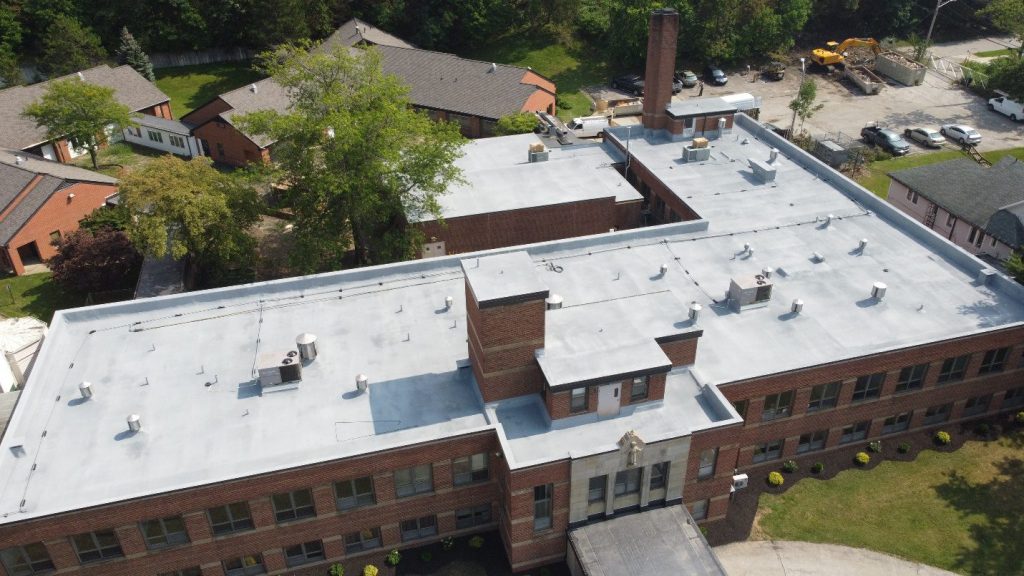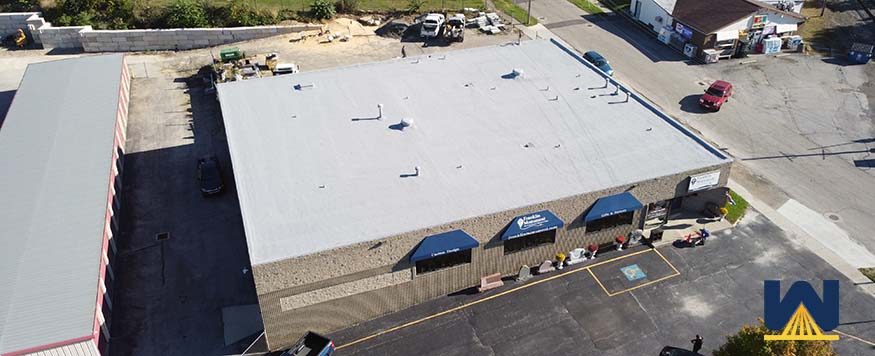Perhaps this is the first time you’re researching SPF (Spray Polyurethane Foam) roofing?
If so, you want to know the basics to see if spray foam is the right solution to your roofing issue.
In this article, we’ll cover:
- How does the process of a spray foam roof begin?
- What equipment comes to your facility and how is it installed?
- How does the warranty work, what options do you have, what’s covered and not covered?
- How much does a typical spray foam roof cost?
- What are the variables that increase or decrease the cost of a spray foam roof installation?
And just so you’re aware, West Roofing Systems has been in commercial roofing since 1979. We specialize in spray polyurethane foam roofing and have installed more than 60 million square feet of SPF.
Every article written at West Roofing Systems is produced in-house and is reviewed and approved by a spray foam and coating expert with more than 30 years of experience.
How does the process of a spray foam roof begin?
The process starts with a discovery call. In that conversation, we’ll get to learn:
- What are the current conditions of the roof?
- Is the roof leaking? If so, where is water coming into the building?
- What are the clients’ short and long-term goals?
- What is the current type of roof system?
- How old is the roof?
- Is there any maintenance or repair history?
After our conversation, if everything makes sense both ways, we will schedule a site visit to walk the roof with you.
Let’s say that it’s a good fit both ways. What equipment comes to the roof? How is the product formed?
What equipment comes to your facility and how is it installed?
Here’s the list of equipment needed to install spray foam:
- 24-ft box truck and a stake side. These need to be parked near the building
- Crew cab
- 2 hoses that are 400-600 feet in length
- Spray gun used by the installers
- Generator
- Air Compressor
- Windscreens and/or a spray foam booth in case of high winds
When we pull into a job site, we would have a 24-foot box truck with equipment in the back that allows us to install the foam roof.
In the truck are two 55-gallon drums. The drums contain the “A-Side” and “B-Side, the two chemicals that combine to make spray foam.
These two chemicals are pumped from the truck, heated and pressurized, and brought up to the roof through a hose.
At the end of the hose is a spray gun where the two materials combine to create foam. What comes out is a liquid that expands 30x in size, cures, and the foam product is created.
The usual thickness is 1-2 inches.
Spray foam will degrade when exposed to UV rays, so the coating is installed to protect the foam.
The truck is equipped with a coating rig. The coating is pumped from the truck through the hose and up to a coating installer.
The coating installer follows behind the foam installer.
Here is a video of a spray foam roof installation from start to finish:
How does the warranty work, what options do you have, and what’s covered?
It’s the building owner’s choice as to what length of warranty they would like.
The length of the warranty is determined by the thickness of the protective coating that’s installed over the spray foam roof.
- For a 10-year warranty, 20 mils of coating are installed
- For a 15-year warranty, 25 mils of coating are installed
- For a 20-year warranty, 30 mils of coating are installed
NOTE: The longer the warranty, the more coating that’s used, which will increase the cost of the project.
It’s also the building owner’s choice as to whom the warranty goes through. You can choose to have the warranty go through the roofing contractor or the manufacturer of the materials used.
Here are some quick points about spray foam roofing warranties:
If you go through the contractor, sometimes repair/service requests get handled faster than going through the manufacturer (who will then contact the contractor). It’s just an easy way to eliminate the middleman.
If you get your warranty through a contractor, sometimes the warranty isn’t transferrable if the company goes out of business. As a business owner making a large investment, you need to make sure the warranty gets transferred (and get it in writing!).
What’s covered (and not covered) in a spray foam roof warranty?
If you have a leak that’s not due to a third party or something outside of the workmanship and the materials that were installed (like damage from a tornado or damage from the HVAC contractor), then the repairs will be covered at no cost to the building owner.
No matter which type of warranty you have, there are a few instances where the damage caused by these events will not be covered. Here are a few examples:
Acts of God – Acts of God would include hail, tornados, and hurricanes. If you live in an area prone to hurricanes, you might want to choose a roofing system that performs well against high winds, like spray polyurethane foam.
Animals – No roofing contractor will cover damage caused by animals.
Other Contractors – There have been plenty of scenarios where another contractor goes onto the roof, causes damage, and the building owner is left wondering who’s going to fix their leak. An example that happens often is an HVAC contractor will go on the roof to service the AC units. They remove the panels and stick them into the spray foam roof. They can also drop a few screws, step on them, and cause a puncture in the spray foam roof. These types of incidents would not be covered under any warranty type.
How much does a typical spray foam roof cost?
A typical spray foam roof will cost $5 – $10 per square foot.

What are the variables that increase or decrease the cost of a spray foam roof installation?
How much wet insulation needs to be removed and replace?
No roofing system should be installed over wet insulation. Core samples and infrared inspections are used to identify wet areas of the roof.
These areas need to be removed and replaced before the installation of any new roofing system.
If your roof requires 25% of the roof to be removed and replaced, versus another roof that only has 2% saturation, the cost of the 2% roof may be lower.
Need to remove an entire roofing system?
Does your current building already have two roofing systems installed? If so, you’ll need to remove at least one roofing system to install a spray foam roof.
Per building code, you can only have two roofing systems on a commercial building.
The cost of your project will be less if you can avoid removing an entire roofing system.
NOTE: If you already have two roofing systems installed, you might be able to avoid a complete tear-off of a roofing system by looking into silicone roof coating systems.
Desired warranty length
Spray foam roofing systems use coating thickness as the #1 factor in determining the length of the warranty.
- For a 10-year warranty, 20 mils of coating are installed
- For a 15-year warranty, 25 mils of coating are installed
- For a 20-year warranty, 30 mils of coating are installed
The longer the warranty length, the more product that’s used, the more costly the project will be.
Desired R-value
Spray polyurethane foam has an R-value of 6.5 per inch of thickness. R-value is a measure of a material’s ability to resist airflow.
The higher the R-value, the less heat or cool that will leave your building through the roof. Increasing your roof’s R-value is an excellent way to reduce your facility’s energy costs.
The higher R-value that’s desired, the more spray foam that’s installed on your roof. More product is going to increase the cost of your project.
What are your next steps?
Now that you know the process, warranty, and cost of a spray foam roof, we think the next best step is to compare SPF to other roofing systems.
Here’s an article that compares SPF, roof coating systems, single-ply, and metal.
If you feel that spray foam might be a good solution, please request a quote and we’ll contact you ASAP.


